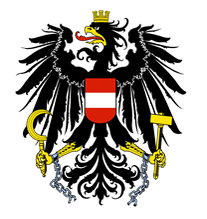Austria: Government
Key Figures
- Chief of State:
- President Alexander Van der Bellen
- Head of Government:
- Chancellor Karl Nehammer
Overview
- Government Name:
- Republic of Austria
- Constitution:
- Formed: 1920; Has 6 main principles: democratic principle, republican principle, federal principle, rule of law, separation of powers, and liberal principle.
- Government Type:
- Federal Republic

Index of Economic Freedom
Country Risk Rating
Government Branches
| Main Powers | Election Process | Election Cycle 1 | |
|---|---|---|---|
| Executive | The president appoints and swears in the federal chancellor, signs bills into law (no power to veto or refuse to sign the bill), and serves as a figurehead for the Austrian government. The Chancellor chairs the weekly cabinet meetings although it does not have the power to direct federal ministers. The Vice-Chancellor acts as a deputy to the federal chancellor. |
The president is elected by an absolute majority vote through a two-round system. The chancellor is appointed by the president. |
President: 6 years; Chancellor: no term limit; Vice-Chancellor: no term limit |
| Judicial | The supreme court of justice or Oberster Gerichtshof consists of 85 judges organized into 17 senates or panels of five judges each and are tasked with upholding the laws stated in the constitution. The constitutional court or Verfassungsgerichtshof consists of 20 judges including 6 substitutes who are tasked with handling the judicial review of administrative acts. The administrative court or Verwaltungsgerichtshof consists of 2 judges plus other members depending on the importance of the case who are tasked with handling the judicial review of administrative acts. |
Supreme court judges are nominated by the executive branch departments and appointed by the president. The constitutional court judges are nominated by several executive branch departments and approved by the president. The administrative court judges are recommended by the executive branch departments and appointed by the president. Terms of judges and members are determined by the president. |
Life appointment |
| Legislative | The national council must resolve a bill for it to become a law, and its approval is also required for most of the prerogatives of the federal assembly to be exercised. The federal council approval is mandatory in regards to constitutional laws/regulations limiting competencies of federal states and treaties concerning the jurisdiction of the federal states. Austria is represented by eight political parties with unicameral legislatures that decide in all matters unless explicitly subject to federal legislation according to the constitution. |
The federal council has 62 members elected by indirect vote. The national council has 183 members who are elected through an open-list proportional representation system. |
National Council: 5 years; General Council: 5 or 6 years |
Regional Trade Blocs
International Organization Participation [2]
Environmental Agreements [3]
Tax Information [2]
- Tax Authority:
- Federal Ministry of Finance
- Tax Name:
- VAT
Sources:
- ElectionGuide http://www.electionguide.org/
- EY, http://www.ey.com
- CIA World Factbook, https://www.cia.gov/the-world-factbook/
- U.S. Bilateral Relations Fact Sheets http://www.state.gov/r/pa/ei/bgn/


